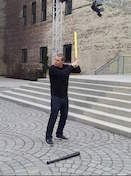My life's mission has been to bring entrepreneurship to students of all ages by inspiring them and giving them the tools they need to succeed. When I started NFTE, I had the simple goal to teach students math, marketing, and communication so that they could launch an idea into a profitable business. When we took this concept into local prisons, we hoped to give convicted felons a path to success outside of the businesses that were not likely to risk hiring them. Here in this column, I've tried to share stories from entrepreneurs around the globe: small time and big time, from every background and in every type of business.
But there is another side of entrepreneurship that is often overlooked: failure. It's something that I'll talk more about in my latest book An Entrepreneur's Manifesto, forthcoming from Templeton Press. But today I want to share the inspiring story of a man I met recently in Princeton. Joshua Termeer drove me up to New York for some meetings and I knew right away that he had the soul and the charisma of an entrepreneur.
Steve Mariotti: Tell us about your first experiences in business.
Joshua Termeer: As a kid, I was always a bit money-grubbing. Perhaps that was in reaction to the hippie lifestyle my parents created, where we eschewed material possessions. In fact, I was undernourished as a baby: we were "living off the land" in a makeshift trailer-log cabin hybrid. It was in a very remote town in Northern California called Hayfork. I wish I was kidding about that name!
In elementary school, I ignored the "Not for Individual Sale" warning on Little Debbie bars and made rice crispy treats and sold them at the bus stop. I also set up a carnival in my back yard, complete with deceptively difficult games.
But my first real business deal was flipping an RV on eBay. I saw that someone was not marketing it well, so on speculation I bought it for $14,000 and sold it for $20,000.
SM: How did you realize your dream to start your own business?
JT: For five years I was living in Europe while attending an international Protestant seminary in Austria and working in Ukrainian orphanages. During that time, I got married and had two kids. By the time we got back in the United States, I was young, with a family to feed, and no useful work experience or degree.
Josh working at a Ukrainian orphanage.
I remembered how I had flipped the RV on eBay and I decided to replicate the deal but with cars. At the time we were living with my in laws while we go settled, so I started flipping cars right out of their driveway. Despite the bad reputation car dealing has, I strove to be honest and transparent and found my success in that business by sniffing out the best deals and connecting with the people I was selling to. I was able make that business profitable enough that soon it made sense to open a dealership, then a second and third and a fourth over the next several years.
Because the state didnt yet have regulation for internet car dealing, we were essentially working in a legal gray area. One day I had the opportunity to explain the situation at length to the Pennsylvania State Police. It was a jarring experience to say the least, and that motivated me to explore something new: being a commercial real estate investor and landlord.
SM: So, how did you get from flipping cars to commercial real estate?
JT: That's when I turned back to my old friend eBay: I listed my dealerships and sold all of them, netting a couple hundred grand. That money allowed me to put 20% down on purchasing the commercial properties where the dealerships were located.
I will share the rest of Joshua's story in Part Two.


